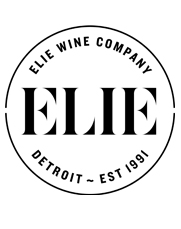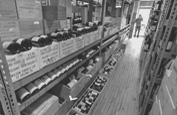Re-imagining Touraine: Young and Talented Duo Jean-Baptiste Bonnigal and Stéphane Bodet Isolate Localities and Varieties to Create Loire Reds and Whites with Expression and Finesse. 6-Bottle (4 White & 2 Red) Sampler Pack $185
This week we feature a pair of remarkable vignerons, Jean-Baptiste Bonnigal and Stéphane Bodet. This talented duo have concentrated their skills on the best plots in Amboise, a six-hundred-acre Touraine appellation where the varietal focus is Côt (Malbec) and Chenin.
With over a hundred acres under their stewardship—32 red and 71 white—they rely on hand-harvesting, organic viticulture and a passion for coaxing out the best qualities from these often under-rated grapes.
Their offerings put a spotlight not only on these varieties, but on what modern biodynamics can do to improve vineyards in a time of changing climate.

Touraine: Smorgasbord of Viticulture
Touraine, sitting precisely midway between Sancerre and Nantes, is known for nothing quite as much as variety. Excelling at white, red, rosé or sparkling wines (made in all three colors), it is a smorgasbord for a wine-lover’s palette.
The white wines are most commonly based on Sauvignon Blanc, which accounts for 43% of Touraine plantings; Chenin Blanc comes a distant second at 7% while Chardonnay may comprise up to 20% of blends while taking up only 3% of vineyard area.
Touraine’s red grape counterparts are led by Gamay, planted in 21% of Touraine’s vineyard area. Cabernet Franc and Malbec (known here as Côt) follow in popularity, with smaller proportions of Cabernet Sauvignon and Pinot Noir found here and there.

AOP Touraine is one of the biggest appellations in the Loire Valley, extending from Chambord to Azay-le-Rideau, passing by Chenonceaux and Chaumont-sur-Loire, overlooking the Loire here and growing along the Cher there. Each denomination has its own personality, its own focus and strength. Azay-le-Rideau makes rosé from Grolleau; Chenonceaux makes reds and rosés from Gamay; Mesland specializes in Sauvignon Blanc as does Touraine-Oisly.
In Touraine Amboise—the area of most interest to Bonnigal and Bodet—has a grape culture influenced by the denomination’s flinty clay soils.
Going Underground in Touraine: Surprisingly Uniform. All About Limestone
If there is a common thread in the great wine regions of Champagne, Burgundy, Chablis, the Loire and southern Rhône valleys—and Saint-Émilion in Bordeaux—it is limestone. Not limestone as a solid rock, which is too hard for vine roots to penetrate, but in the form of plant-accessible calcium carbonate (the principal chemical component of limestone) typically from decayed outcroppings.
There are multiple reasons for this, but most of them involve water. Calcium-based soils have water-retention properties that are ideal for growing vines; water is essential for cation exchange (the process by which plants take up nutrients through their roots). But the same vines will suffer in waterlogged soils. Calcium-rich soil has a chemical structure composed of molecular sheets held together by ionic attractions, a structure that permits the soil to retain moisture in periods of dry weather and allows for good drainage during heavy rains.
In Touraine’s limestone underpinning was created through the uplifting of the extensive limestone beds of the Paris Basin during the Pleistocene era, which began about between 2.5 million years ago and lasted until relatively recently, about 11,700 years ago. It diverted the flow of the Loire Séquanaise, shifting its course away from the north. As it did so it joined up with the lower section, creating the Loire as we know it today. So dominant is the limestone in the terroir of Touraine that particular type is named for the appellation: Turonian limestone is, in places, 400 feet deep.
2022: Solar Vintage Tamed
The 2022 vintage in Touraine is entitled to wear the vigneron’s badge ‘solar vintage.’ As the name suggests, the 2022 growing season was aggressively warm and sunny. In general, this leads to optimal conditions for any flora, including grapes. The irony is, optimal conditions may produce lackluster wines while struggling vines tend to produce juice that is concentrated and complex. Also, when grapes ripen too quickly, they lose acidity, which is the irreplaceable counterpoint to sugar is a balanced wine.
Fortunately, the solution in Touraine was early and optimal picking, before the grapes became so ripe that ultimate alcohol percentages climbed to the roof—this is a double whammy to quality. Lower acidities work better with modest alcohol levels, and this is precisely what you will find in 2022 Touraine.
Bonnigal-Bodet, Vignerons
Touraine-Amboise
“One of the Revelations of Recent Years in Touraine!” La Revue du Vin de France ‘Guide Vert 2025’
In the wonderful fusion of winemaking and entrepreneurial passion, we frequently celebrate obscure producers working from miniscule plots of vines. We may write about winemakers working from a few hand-tended acres, often in inhospitable terrain. But when you move from rural mountain vineyards in Priorat to the sprawling gardens of the Loire, it is sometimes surprising to see how large some of the holdings are. And it is refreshing to realize that size does not diminish passion.
In 2015, Jean-Baptiste Bonnigal and Stéphane Bodet jointly took over Bonnigal’s 136-acre, fourth-generation family domain in Limeray, near Amboise—the heart of the Loire valley. Having trained in both New Zealand and Bordeaux (they met while studying in Montagne-Saint-Émilion), the winemakers focus on organic and biodynamic practices to create wines of precision and purity.
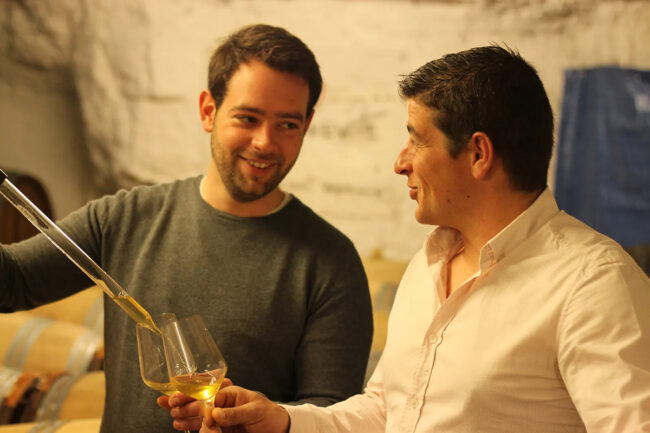
Jean-Baptiste Bonnigal and Stéphane Bodet, Bonnigal-Bodet, Vignerons
Says Jean-Baptiste: “I invited Stéphane to join me in Limeray because we share the same professional goals and have a similar perspective on nature. We embrace the land and diligently working the vineyards with regular aerating of the soil by hoeing every two weeks. We promote and support microbial life by cultivating various plants and treat vines are treated only when absolutely necessary.”
These are sentiments echoed by Stéphane: “For us, our terroir best transcribed through the environment in which a vine flourishes. We are also convinced that wine is produced in the vineyard before being transformed into nectar, so we are very little interventionist in the cellar in order to allow the wine to express itself in the most natural way and with all the complexity that the word ‘terroir’ implies. Our key direction is respect; respect for the soils, for the grapes, for the environment, for the process that transforms the juice into wine.”
Varietal Focus: Highlighting Chenin and Côt
Known locally as ‘Pineau Blanc de la Loire,’ Touraine lock on quality Chenin is most evident in Vouvray, but the rest of the appellation creates Chenin of depth and electricity. The cool climate and sharp acidity allow this often neutral variety to take on amazing nuance whether vinified dry, off-dry, or decadently sweet.
Although delightful upon release, the characteristic of Touraine Chenin that is most striking is its ability develop tertiary notes with age; in fact, unlike the Sauvignon Blancs and Chardonnay produced here, cellar-worthy Chenins are the rule rather than the exception.
Côt—the Touraine word for Malbec—is another variety that is pampered toward perfection by the vignerons of Touraine, who often blend it with Cabernet Franc. Côt brings color, body and specific aromas to wine, notably pepper and licorice. Like Touraine Chenin, Côt—vinified with this end in mind—is noted for its ability to mature with age.
 1 Bonnigal-Bodet, Vignerons ‘Clocher – Chenin’, 2022 Touraine-Amboise Blanc ($35)
1 Bonnigal-Bodet, Vignerons ‘Clocher – Chenin’, 2022 Touraine-Amboise Blanc ($35)
Le Clocher is a south-facing, clay-limestone plot above the village of Limeray where the Chenin vines are 25 years old. The grapes are carefully sorted, then direct pressed Alcoholic fermentation occurs spontaneously with native yeasts in 620 liter demi-muids followed by 8 months of aging on fine lees. The wine is bottled with 1.8 grams/liter of residual sugar and coats the tongue with texture, offering spicy apple, fresh peaches and a touch of marmalade on the finish.
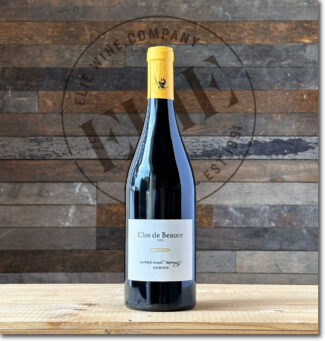 2 Bonnigal-Bodet, Vignerons ‘Clos de Beauce – Chenin’, 2022 Touraine-Amboise Blanc ($35)
2 Bonnigal-Bodet, Vignerons ‘Clos de Beauce – Chenin’, 2022 Touraine-Amboise Blanc ($35)
100% Chenin from a historic, south-facing Cangey vineyard where vine age is 50 to 70 years. The ‘Beauce’ name derives from the limestone terroir. The grapes are hand-harvested, direct-pressed and fermented on native yeasts in a combination of 225-liter neutral barriques and 620-liter demi-muids. Aged a full year on the lees, it is bottled without malolactic and with 1 gram/liter of residual sugar left behind. The wine shows baked apple, pear, ripe citrus, toasted nuts with hints of honeysuckle and wet stone.
 3 Bonnigal-Bodet, Vignerons ‘Buisson – Chenin’, 2022 Touraine-Amboise Blanc ($44)
3 Bonnigal-Bodet, Vignerons ‘Buisson – Chenin’, 2022 Touraine-Amboise Blanc ($44)
Buisson is made from younger vines, under ten years in age; it is the processing that really builds the depth in this 100% Chenin: The cuvée is aged a full 20 months; 12 months in 620-liter demi-muids on fine lees and 8 months in stainless-steel vats. The wine is then bottled with 2 gram/liter of residual sugars. It shows a distinctively sweet floral aroma and the tangy savor of grapefruit.
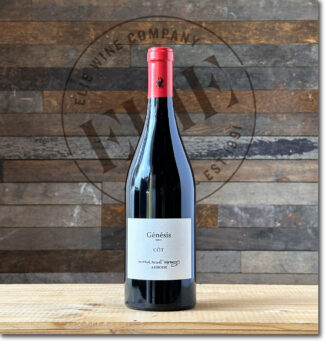 4 Bonnigal-Bodet, Vignerons ‘Génésis – Côt’, 2022 Touraine-Amboise Rouge ($31)
4 Bonnigal-Bodet, Vignerons ‘Génésis – Côt’, 2022 Touraine-Amboise Rouge ($31)
100% Côt that has been harvested manually and sorted on a vibrating table. Carbonic maceration is whole bunch and occurs over nine days of vatting followed by nine months of stainless-steel aging. The wine displays cassis and blackberry liqueur with fresh, forward fruit and silky tannins.
 5 Bonnigal-Bodet, Vignerons ‘Diabolicôt’, 2022 Touraine Rouge ($20)
5 Bonnigal-Bodet, Vignerons ‘Diabolicôt’, 2022 Touraine Rouge ($20)
As the devilish name suggests, Diabolicôt is 100% Malbec, known as Côt in Touraine. The grapes are harvested by hand, and undergo carbonic maceration in foudres following which they ferment on indigenous yeasts for 10 days. Aging last eight months on fine lees; the wine shows bold grape tannins and subtle oak notes behind rich blueberry-plum jam.
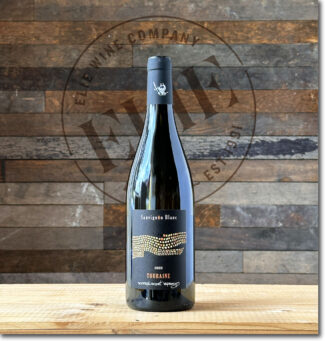 6 Bonnigal-Bodet, Vigneron ‘Sauvignon Blanc’, 2022 Touraine Blanc ($20)
6 Bonnigal-Bodet, Vigneron ‘Sauvignon Blanc’, 2022 Touraine Blanc ($20)
Hand harvested and fermented on indigenous yeasts, the wine ages on fine lees for three months in stainless steel and is bottled without malolactic. It displays a pale-yellow hue glinted with hints of gold and shows a citrus bouquet (especially grapefruit) complemented by a delightful floral finish.
Notebook …
Talented Artisan Vignerons in Touraine: A Quiet Revolution
Land at bargain basement prices in the Garden of France? Touraine, bolstered by the presence of the SAFER group (which controls the sale of agricultural land) is so welcoming to newcomers that it seems an obvious destination for new artisanal winemakers looking to make their mark. This is not a new phenomenon; the AOP has been attracting new waves of natural winemakers since the 1990s.
In fact, so flexible has the region been for young iconoclasts leaning toward experimentation that a new dilemma has arisen: How to find the ideal style and substance to best showcase Touraine’s remarkable terroirs? Ancient varieties like Pineau d’Aunis have retained a foothold while standbys like Sauvignon Blanc are being shifting to supporting roles. As always, tuffeau and flint produce a compelling expression of Chenin—one that is edgier and more bracing than elsewhere—and as these wines grow more popular, another quandary may loom among these talented freshmen (and freshwomen): How can they avoid becoming a monoculture appellation driven by financial success where everyone is chasing the same thing?
- - -
Posted on 2024.10.17 in Touraine, France, Wine-Aid Packages, Loire
Featured Wines
- Notebook: A’Boudt Town
- Saturday Sips Wines
- Saturday Sips Review Club
- The Champagne Society
- Wine-Aid Packages
Wine Regions
Grape Varieties
Albarino, Albarín Tinto, Alicante Bouschet, Aligote, Altesse, Arbanne, Auxerrois, Barbarossa, barbera, Biancu Gentile, Bonarda, bourboulenc, Cabernet Sauvignon, Calvi, Carcajolu-Neru, Chenin Blanc, Cinsault, Clairette, Cortese, Corvinone, Cot, Counoise, Dolcetto, Erbamat, Fiano, folle Blanche, Fromenteau, Fumin, Gamay, Garganega, Garnacha Tintorera, Gewurztraminer, Godello, Graciano, Grenache Blanc, Groppello, Jacquère, Juan Garcia, Lladoner Pelut, Loureira, Macabeo, Maconnais, Malbec, manseng, Marcelan, Marsanne, Marselan, Marzemino, Melon de Bourgogne, Mencía, Merlot, Montanaccia, Montepulciano, Montònega, Moscatell, Mourv, Mourvèdre, Muscadelle, Muscat, Natural, Nebbiolo, Niellucciu, Palomino, Parellada, Patrimonio, Pecorino, Pedro Ximénez, Persan, Petit Meslier, Pineau d'Aunis, Pinot Auxerrois, Pinot Blanc, Pinot Gris, Pinot Meunier, Pinot Noir, Pouilly Fuisse, Pouilly Loche, Riesling, Rousanne, Sagrantino, Sangiovese, Sauvignon, Sauvignon Blanc, Sciacarellu, Semillon, Serine, Sparkling, Sumoll, Tempranillo, Teroldego, Timorasso, Trebbiano, Trebbiano Valtenesi, trepat, Ugni Blanc, Verdicchio, Vermentino, Viognier, Viura, Xarel-loWines & Events by Date
- September 2025
- August 2025
- July 2025
- June 2025
- May 2025
- April 2025
- March 2025
- February 2025
- January 2025
- December 2024
- November 2024
- October 2024
- September 2024
- August 2024
- July 2024
- June 2024
- May 2024
- April 2024
- March 2024
- February 2024
- January 2024
- December 2023
- November 2023
- October 2023
- September 2023
- August 2023
- July 2023
- June 2023
- May 2023
- April 2023
- March 2023
- February 2023
- January 2023
- December 2022
- November 2022
- October 2022
- September 2022
- August 2022
- July 2022
- June 2022
- May 2022
- April 2022
- March 2022
- February 2022
- January 2022
- December 2021
- November 2021
- October 2021
- September 2021
- August 2021
- July 2021
- June 2021
- May 2021
- April 2021
- March 2021
- February 2021
- January 2021
- December 2020
- November 2020
- October 2020
- September 2020
- August 2020
- July 2020
- June 2020
- May 2020
- April 2020
- March 2020
- February 2020
- January 2020
- December 2019
- November 2019
- October 2019
- September 2019
- August 2019
- July 2019
- June 2019
- May 2019
- April 2019
- March 2019
- February 2019
- January 2019
- December 2018
- November 2018
- October 2018
- September 2018
- August 2018
- July 2018
- June 2018
- May 2018
- April 2018
- March 2018
- February 2018
- January 2018
- December 2017
- November 2017
- October 2017
- September 2017
- August 2017
- July 2017
- June 2017
- May 2017
- April 2017
- March 2017
- February 2017
- January 2017
- December 2016
- November 2016
- October 2016
- September 2016
- August 2016
- July 2016
- June 2016
- May 2016
- April 2016
- March 2016
- February 2016
- January 2016
- December 2015
- November 2015
- October 2015
- September 2015
- August 2015
- July 2015
- June 2015
- May 2015
- April 2015
- March 2015
- February 2015
- January 2015
- December 2014
- November 2014
- October 2014
- September 2014
- August 2014
- July 2014
- June 2014
- April 2014
- March 2014
- February 2014
- January 2014
- December 2013
- November 2013
- October 2013
- September 2013
- August 2013
- July 2013
- June 2013
- May 2013
- April 2013
- March 2013
- February 2013
- January 2013
- December 2012
- November 2012
- October 2012
Search
